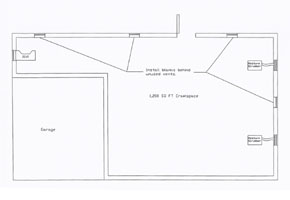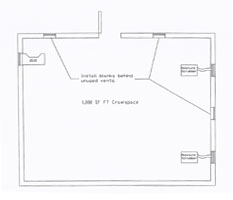|
Crawlspace Ventilation
Crawlspace Buddy
|
|
System Configurations
Click thumbnails below to view larger image
.jpg) |
Example shows 2,000 sq foot crawlsapce with wraparound porch
|
|
|
|
|
|
This drawing shows a fairly large and cut up foundation. The basic idea of our system is to pull air across the area. The extended wraparound porches create an interesting problem. Foundation walls within the crawlspace area act as baffles to air movement. Other items do the same, such as duct work for the HVAC and just the seer distance form one side of the house to the other. I have found that air will not exchange, without depressurization, more than 15 feet. Dead air plus moisture equals mold and rot.
The entire crawlspace area must be considered, even the area under the elevated porches. If these wraparound porches had wooden floors, like a deck, the area below them would not be considered in our calculations. However, if the porches are poured concrete, they must be added to the exchange calculation. Trapped moisture under this area will directly effect the crawlspace if they are contiguous, and they are.
Another consideration with this foundation is the wall around the garage area. No vents along this area pushed the location of Zeus to its shown location. By placing Zeus close to the garage, air will be pulled around the crawl from the Moisture Scrubber at the bottom right.
One other consideration is the offset at the rear of the house. Offsets should get a Scrubber wherever they occur. It is difficult to wick moisture from an offset, it tends to isolate itself. So if you have offsets more than five feet deep, add a Scrubber at the end of each.
Depending on the height of the crawl, the timer would be adjusted for running time. Let’s say you have close to four feet from the dirt to the bottom of the floor joist. We will add one foot for area the joists take up to the floor decking just to get an approximate total area.
2,000sqft x 5’ = 10,000 cubic feet of air. Lets say that the covered wraparound porches add 1,000 sqft times 4’ which = 4,000 cubic feet. This gives us a grand total of 14,000 cubic feet to deal with. We move 510 cubic feet per minute of running time. So in one hour we have exhausted 30,600 cubic feet of air or 2 exchanges each hour. We would like to exchange the air in this area 30 times each day. 30 (exchanges) divided by 2 (exchanges per hour of running time) equals fifteen (hours of running time needed). We also want to do this exchange over a 24-hour period cut into four cycles. So if we set the timers to run "four hours", each cycle and obtain about 500,000 (cubic feet moved a day) which is about 35 exchanges per day. This is a good number of exchanges for an area of this size.
|
|
|
|
|
|
 |
Example shows 1,200 sq foot crawlspace
|
|
|
This drawing shows a fairly typical layout of a foundation. The basic idea of our system is to pull air across the area. I have found that areas like the bottom left of this drawing will dry out with a little time. I used to add a fan to disturb the air in dead zones but wet air moves toward dryer air. As we dry out the air adjacent to this wetter air, it must give it up. With time, this zone, with no vents, will dry out. All unused foundation vents are sealed with blanks that are supplied (four blanks in each Moisture Scrubber box) with each Moisture Scrubber. This is to insure that the majority of the makeup air comes through the Scrubbers.
Depending on the height of the crawl, the timer would be adjusted for running time. Let’s say you have close to four feet from the dirt to the bottom of the floor joist. We will add one foot for area the joists take up to the floor decking just to get an approximate total area.
1,200sqft x 5’ = 6,000 cubic feet of air. We move 510 cubic feet per minute of running time. So in one hour we have exhausted 30,600 cubic feet of air, or 5 exchanges each hour. We would like to exchange the air in this area 30 times each day. 30 (exchanges) divided by 5 (exchanges per hour of running time) equals six (hours of running time needed). We also want to do this exchange over a 24-hour period cut into four cycles. So if we set the timers to run "two hours", each cycle and obtain 244,800 (cubic feet moved a day) which is a little over 40 exchanges per day. This is the maximum number of exchanges we would want to provide. Once you exchange more than 40 times, your crawlspace will experience heat gain in the summer and nullify the effectiveness of the Moisture Scrubbers. Our Scrubbers use the cooler crawlspace air temperature to extract moisture from the incoming air.
|
|
|
|
|
|
 |
Example shows 1,000 sq foot crawlsapce
|
|
|
This drawing shows a fairly simple layout of a foundation. The basic idea of our system is to pull air across the area. I have found that areas like the bottom left of this drawing will dry out with a little time. I used to add a fan to disturb the air in dead zones but wet air moves toward dryer air. As we dry out the air adjacent to this wetter air, it must give it up. With time this zone, with no vents, will dry out. All unused foundation vents are sealed with blanks that are supplied (four blanks in each Moisture Scrubber box) with each Moisture Scrubber. This is to insure that the majority of the makeup air comes through the Scrubbers.
Depending on the height of the crawl, the timer would be adjusted for running time. Let’s say you have close to three feet from the dirt to the bottom of the floor joist. We will add one foot for area the joists take up to the floor decking just to get an approximate total area.
1,000sqft x 4’ = 4,000 cubic feet of air. We move 510 cubic feet per minute of running time. So in one hour we have exhausted 30,600 cubic feet of air, or 7.5 exchanges. We would like to exchange the air in this area 30 times each day. We also want to do this exchange over a 24 hour period cut into four cycles. So if we set the timers to run "one hour", four times a day we have our desired number of exchanges. 7.5 x 4 = 30 exchanges each day.
|
|
|
|